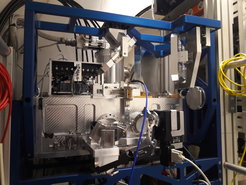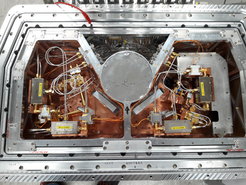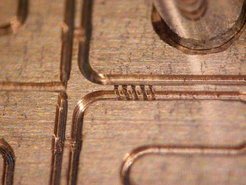NFLASH

The NFLASH receiver system is a state of the art heterodyne single pixel spectrometer installed at the APEX telescope in Chile. It has the capability to perform simultaneous dual polarization observations in three important frequency bands: 200-270 GHz, 385-510 GHz and 780-950 GHz. Using the latest technology of optical frequency filters (dichroics) and dual sideband (2SB) SIS mixers a total instantaneous IF bandwidth of up to 80 GHz (i.e. 4x8+4x4+4x8) allows a fast and efficient use of the telescope time and enables parallelization of line surveys across the covered frequency bands. The instrument is optimized for observation of point sources and provides unique science opportunities to the APEX communities.

The receiver system consists of two independent instruments connected via a select optics system which allows to select any combination of the frequency bands to adapt to the specific scientific use cases and thus enables observation at the lowest possible noise temperature.
The first part of the receiver system including the two lower frequency bands was build as part of the MPIfR contribution to the APEX-II refurbishment and is dedicated as APEX facility instrument. It was installed in January 2020 at the APEX telescope. The construction of the second part hosting the high frequency channel of the receiver system is currently ongoing and is expect to be commissioned as PI instrument in 2021.

The facility receiver allows observations in the frequency bands which were formerly covered by the decommissioned PI-230 and the FLASH+ high frequency channel. Similar as the PI-230 the facility receiver was designed to take part in VLBI observations of the EHT campaign. The SSB noise temperatures range between 60-90 K for the band from 200-270 GHz and between 100-200 K for the band from 385-510 GHz, with an IRR of more than 15 dB in minimum 80% of the band.
The upcoming PI part will allow observation of high-J CO lines and other fundamental molecules to supplement NFLASH multi-band analysis and to complete the astronomical window covered by the APEX telescope. The receiver will host the first available 2SB SIS mixer in the frequency range from 780-950 GHz (ALMA band 10). These mixers were produced in cooperation with the NOVA submm instrumentation group at the Kapteyn institute in Groningen, while all mechanical parts including the mixer blocks (branchline coupler / hybrid structures) were manufactured at the MPIfR workshop. First results promise a reliable operation using a total IF band width of 8 GHz per sideband at reasonable noise temperatures around 450-900 K, with an IRR above 15 dB in 95% of the band [doi: 10.1109/TTHZ.2019.2939003].




